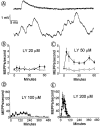Effects of 2-(4-morpholinyl)-8-phenyl-4H-1-benzopyran-4-one on synaptic vesicle cycling at the frog neuromuscular junction
- PMID: 12486161
- PMCID: PMC6758452
- DOI: 10.1523/JNEUROSCI.22-24-10680.2002
Effects of 2-(4-morpholinyl)-8-phenyl-4H-1-benzopyran-4-one on synaptic vesicle cycling at the frog neuromuscular junction
Abstract
Inositol phospholipids are thought to play an important regulatory role in synaptic membrane traffic. We investigated the effects of perturbing 3-phosphoinositide metabolism on neurotransmission at the frog neuromuscular junction. We used the reversible phosphoinositide-3 kinase (PI3K) inhibitor 2-(4-morpholinyl)-8-phenyl-4H-1-benzopyran-4-one [LY294002 (LY)] and we examined its effects by intracellular recording, fluorescence imaging with styryl dyes (FM 1-43 and FM 2-10), calcium imaging, and electron microscopy. LY treatment reversibly inhibited vesicle cycling; electron micrographs indicated a dramatic reduction in the number of vesicles, balanced by the appearance of numerous cisternas. LY wash-off reverted the phenotype; terminals were refilled with vesicles, and they resumed normal FM 1-43 uptake and release. Surprisingly, LY treatment also enhanced the frequency of spontaneous release up to 100-fold in a calcium-independent manner. LY evoked similar effects in normal frog Ringer's solution, Ca-free Ringer's solution, and BAPTA AM-pretreated preparations; imaging of nerve terminals loaded with the calcium-sensitive fluorescent dye fluo-3 showed no significant change in fluorescence intensity during LY treatment. FM 1-43 imaging data suggested that LY evoked the cycling of 70-90% of all vesicles. The LY-induced effect on spontaneous release was reproduced by the casein kinase 2 inhibitor 5,6-dichlorobenzimidazole riboside but not, however, by the PI3K inhibitor wortmannin. Because LY has been shown recently to potently inhibit casein kinase 2 as well as PI3K, we hypothesize that casein kinase 2 inhibition is responsible for the enhancement of spontaneous release, whereas PI3K inhibition induces the block of vesicle cycling.
Figures








References
-
- Adi S, Wu NY, Rosenthal SM. Growth factor-stimulated phosphorylation of Akt and p70(S6K) is differentially inhibited by LY294002 and wortmannin. Endocrinology. 2001;142:498–501. - PubMed
-
- Angleson JK, Betz WJ. Intraterminal Ca2+ and spontaneous transmitter release at the frog neuromuscular junction. J Neurophysiol. 2001;85:287–294. - PubMed
-
- Ashton AC, Rahman MA, Volynski KE, Manser C, Orlova EV, Matsushita H, Davletov BA, van Heel M, Grishin EV, Ushkaryov YA. Tetramerisation of alpha-latrotoxin by divalent cations is responsible for toxin-induced non-vesicular release and contributes to the Ca2+-dependent vesicular exocytosis from synaptosomes. Biochimie. 2000;82:453–468. - PubMed
-
- Ashton AC, Volynski KE, Lelianova VG, Orlova EV, Van Renterghem C, Canepari M, Seagar M, Ushkaryov YA. alpha-Latrotoxin, acting via two Ca2+-dependent pathways, triggers exocytosis of two pools of synaptic vesicles. J Biol Chem. 2001;276:44695–44703. - PubMed
Publication types
MeSH terms
Substances
Grants and funding
LinkOut - more resources
Full Text Sources
Other Literature Sources
